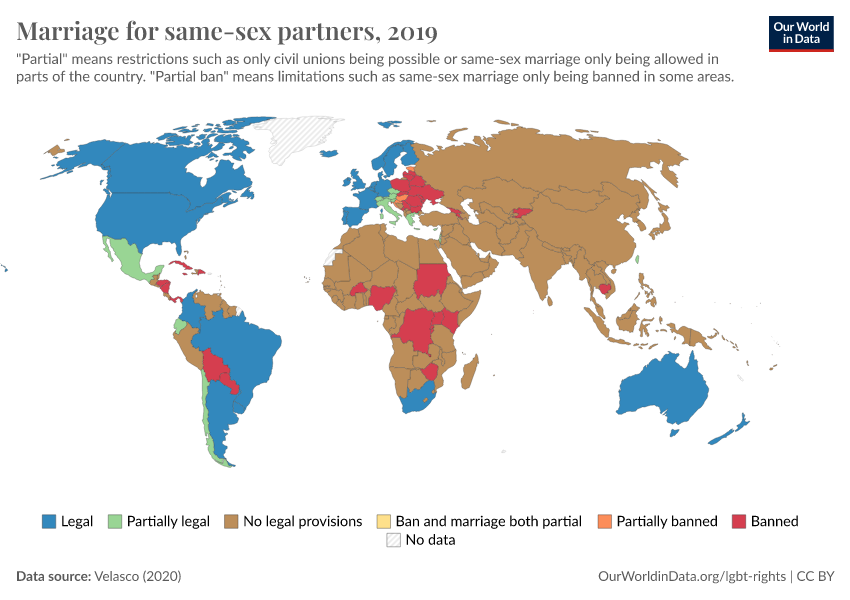Marriage for same-sex partners

What you should know about this indicator
The indicator is coded as follows: Legal (equal marriage is legal and fully implemented. There might be civil unions or not), Partially legal (equal marriage is legal, but not fully implemented. There might be civil unions or not), _No legal provisions_ (there are no laws regulating marriage equality nor civil unions), Ban and marriage both partial (equal marriage is partially implemented or equal marriage is banned but not fully implemented. Civil unions are partially implemented as well), Partially banned (equal marriage is banned but not fully implemented or it is banned but there is partial implementation of civil unions or equal marriage) and Banned (equal marriage is banned and fully implemented. There are no civil unions).
What you should know about this indicator
The indicator is coded as follows: Legal (equal marriage is legal and fully implemented. There might be civil unions or not), Partially legal (equal marriage is legal, but not fully implemented. There might be civil unions or not), _No legal provisions_ (there are no laws regulating marriage equality nor civil unions), Ban and marriage both partial (equal marriage is partially implemented or equal marriage is banned but not fully implemented. Civil unions are partially implemented as well), Partially banned (equal marriage is banned but not fully implemented or it is banned but there is partial implementation of civil unions or equal marriage) and Banned (equal marriage is banned and fully implemented. There are no civil unions).
Sources and processing
This data is based on the following sources
How we process data at Our World in Data
All data and visualizations on Our World in Data rely on data sourced from one or several original data providers. Preparing this original data involves several processing steps. Depending on the data, this can include standardizing country names and world region definitions, converting units, calculating derived indicators such as per capita measures, as well as adding or adapting metadata such as the name or the description given to an indicator.
At the link below you can find a detailed description of the structure of our data pipeline, including links to all the code used to prepare data across Our World in Data.
Notes on our processing step for this indicator
We estimated regional aggregations by using Our World in Data definitions of regions and our consolidated population data.
From the original dataset, we combined data from three different indicators: marriage equality, ban on marriage equality and civil unions.
Reuse this work
- All data produced by third-party providers and made available by Our World in Data are subject to the license terms from the original providers. Our work would not be possible without the data providers we rely on, so we ask you to always cite them appropriately (see below). This is crucial to allow data providers to continue doing their work, enhancing, maintaining and updating valuable data.
- All data, visualizations, and code produced by Our World in Data are completely open access under the Creative Commons BY license. You have the permission to use, distribute, and reproduce these in any medium, provided the source and authors are credited.
Citations
How to cite this page
To cite this page overall, including any descriptions, FAQs or explanations of the data authored by Our World in Data, please use the following citation:
“Data Page: Marriage for same-sex partners”, part of the following publication: Bastian Herre and Pablo Arriagada (2023) - “LGBT+ Rights”. Data adapted from Velasco. Retrieved from https://archive.ourworldindata.org/20251023-195030/grapher/marriage-for-same-sex-partners-velasco.html [online resource] (archived on October 23, 2025).How to cite this data
In-line citationIf you have limited space (e.g. in data visualizations), you can use this abbreviated in-line citation:
Velasco (2020) – with major processing by Our World in DataFull citation
Velasco (2020) – with major processing by Our World in Data. “Marriage for same-sex partners” [dataset]. Velasco, “LGBT+ policies (Kristopher Velasco)” [original data]. Retrieved January 16, 2026 from https://archive.ourworldindata.org/20251023-195030/grapher/marriage-for-same-sex-partners-velasco.html (archived on October 23, 2025).